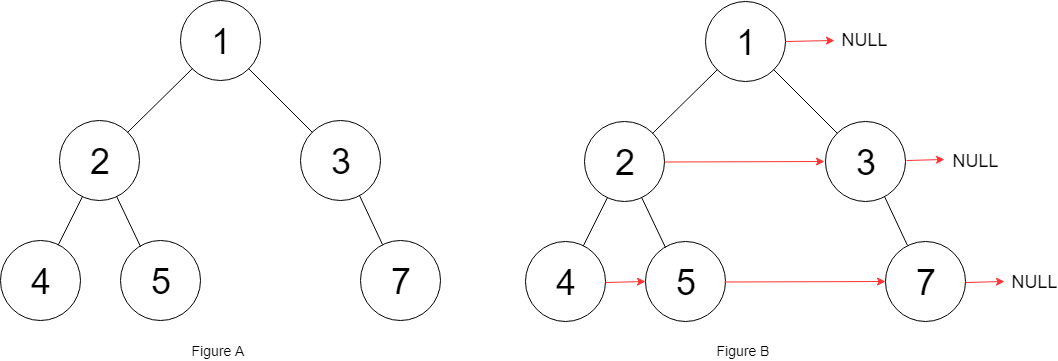117. 填充每一个节点下一个右侧节点指针
给定一个二叉树
struct Node {
int val;
Node *left;
Node *right;
Node *next;
}
填充它的每个 next 指针,让这个指针指向其下一个右侧节点。如果找不到下一个右侧节点,则将 next 指针设置为 NULL。
初始状态下,所有 next 指针都被设置为 NULL。
进阶:
你只能使用常量级额外空间。
使用递归解题也符合要求,本题中递归程序占用的栈空间不算做额外的空间复杂度。
示例:

输入:root = [1,2,3,4,5,null,7]
输出:[1,#,2,3,#,4,5,7,#]
解释:给定二叉树如图 A 所示,你的函数应该填充它的每个 next 指针,以指向其下一个右侧节点,如图 B 所示。序列化输出按层序遍历顺序(由 next 指针连接),'#' 表示每层的末尾。
提示:
树中的节点数小于 6000
-100 <= node.val <= 100
链接:https://leetcode-cn.com/problems/populating-next-right-pointers-in-each-node-ii
此题目与116题一起看,116为完美二叉树,但解法都是通用的
/*
// Definition for a Node.
class Node {
public int val;
public Node left;
public Node right;
public Node next;
public Node() {}
public Node(int _val) {
val = _val;
}
public Node(int _val, Node _left, Node _right, Node _next) {
val = _val;
left = _left;
right = _right;
next = _next;
}
};
*/
class Solution {
public Node connect(Node root) {
dfs(root,0,new ArrayList<>());
return root;
}
public void dfs(Node root,int depth,ArrayList<Node> temp)
{
if(root==null)
return;
if(temp.size()<=depth)
{
temp.add(root);
}else
{
temp.get(depth).next=root;
temp.set(depth, root);
}
dfs(root.left,depth+1,temp);
dfs(root.right,depth+1,temp);
}
}
非递归方式,效率不好,
class Node {
public int val;
public Node left;
public Node right;
public Node next;
public Node() {}
public Node(int _val) {
val = _val;
}
public Node(int _val, Node _left, Node _right, Node _next) {
val = _val;
left = _left;
right = _right;
next = _next;
}
};
public class Solution {
public Node connect(Node root) {
if(root==null) return null;
LinkedList<Node> queue=new LinkedList<>();
Node cur;
queue.addLast(root);
while (!queue.isEmpty())
{
int count=queue.size();
for(int i=0;i<count-1;i++)
{
cur=queue.pollFirst();
if(cur.left!=null)
{
queue.addLast(cur.left);
}
if(cur.right!=null)
{
queue.addLast(cur.right);
}
cur.next=queue.peekFirst();
}
cur=queue.pollFirst();
if(cur.left!=null)
{
queue.addLast(cur.left);
}
if(cur.right!=null)
{
queue.addLast(cur.right);
}
}
return root;
}
}

